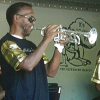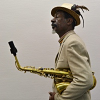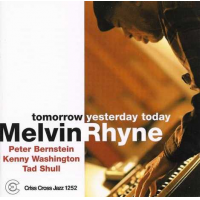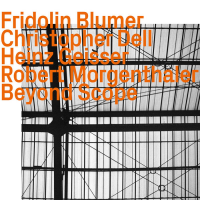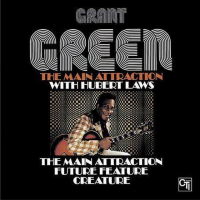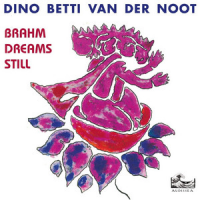Home » Jazz Articles » Liner Notes » Sun Ra at Inter-Media Arts, 1991
Sun Ra at Inter-Media Arts, 1991
He had arrived on our planet in Birmingham, Alabama in 1914, named Herman Poole Blount by his mother after a vaudeville magician billed as Black Herman who had deeply impressed her. The boy's family called him "Sonny." He showed musical promise as a pre-teen, teaching himself piano, composition and sight-reading. Soon Sonny Blount was playing semi-professionally in rhythm and blues and pickup groups. After hearing performances by touring big bands, he would transcribe their arrangements from memory.
At Birmingham's racially segregated Industrial High School Sonny took music classes from the well-respected disciplinarian John T. "Fess" Whatley. Although socially remote, perhaps due in part to his painful and embarrassing cryptorchidism, Sonny was an honor roll student. He found his way to the library kept by the local Black Masonic Lodge, where he read about the tenets of Freemasonry, among other esoteric, arcane texts. Fascinating details of Sun Ra's upbringing, education and early career which he had obscured are revealed in John Szwed's wonderful 1998 biography Space Is The Place, including stories about the sympathetic teacher who took him under her wing, his first orchestra, the dramatic costumes and scenery typically used in Birmingham's black entertainment venues, and his travails as a conscientious objector in World War II, which included his incarceration, near mental breakdown, assignment as a forester, estrangement from his family and eventual reclassification as unfit for service.
Perhaps most significantly to Ra himself was the experience he claimed to have had in the late 1930s of being swept off to Saturn by extraterrestrials. He evidently didn't share this story until a decade or so later, but even then UFO abduction was not a common trope. Of course, there was never anything commonplace about L'Sony Ra, the name he took legally in 1952, seven years after leaving Alabama for the music-rich South Side of Chicago, a capitol of African-American culture. It was from that environment, and the apprenticeship he served at the Club DeLisa under the great though then-failing Swing Era composer-arranger Fletcher Henderson, that Sun Ra launched his extraordinary career.
You are probably already familiar with Sun Ra's art from one or more of the 125 or so albums which he recorded, the majority of them issued by his own small batch El Saturn Records label. Those albums, with covers hand-decorated by Arkestra members, were usually sold at their concerts (several were reissued by Impulse! in the 1970s). My own first exposure to the man and his music was through The Heliocentric Worlds of Sun Ra, Volume 2, issued by ESP Disks in 1965. It comprised two long, studio-recorded tracks, and was illustrated with graphics that placed Ra among the big thinkers da Vinci, Copernicus, Pythagoras, Galileo and Tycho Brae. Even in the era of "free jazz" heralded by Albert Ayler, Ornette Coleman, John Coltrane and Cecil Taylor, Heliocentric Worlds was rife with mystifying sounds and the weirdest cover art. To this day I'm not sure why the whole thing felt so right to me. But it did—and led me into explorations of music and ideas I've pursued ever since.
If Sun Ra had that affect on a naïve, uninformed listener, his impact was infinitely greater on the musicians he gathered. Many of them accepted his dictates on and off the bandstand, living communally almost like family, traveling together as a tribe. The most devoted of them—namely tenor saxophonist John Gilmore and alto saxophonist Marshall Allen—signed on in the 1950s, were featured in the Intermedia-Arts concert and remained loyal past his ascension. Gilmore took over leadership of the Arkestra upon Ra's departure in 1993, even though he was weakened by emphysema; he died in 1995. Marshall Allen, the impish, ferocious improviser who was among the first to seriously take up on EVI (electronic valve instrument), appears to be undiminished now at age 92, fronting the Arkestra on its never-ending tour.
James Jacson, who drives the powerful introduction that opens this album using his Ancient Egyptian Infinity drum (a chest-high, conga-shaped instrument which he struck with talking drum-like curved sticks) had joined the Arkestra during its mid-'60s weekly residency on Monday nights at the East Village club Slug's. June Tyson, whose coolly floating voice is front and center of "Springtime Again" (with Marshall Allen adding flute obbligato), was enlisted around 1968 as the Arkestra's first and only female member. Ra was generally uncomfortable with women, yet Tyson became his costume adviser and trusted companion. Her reading of the opening lyric is stately yet sadly ironic, as she had been diagnosed with cancer and soon after; this is probably her last recording.
"Advice to Medics" was one of the oldest titles in the Arkestra's repertoire, first recorded on the 1956 album Super-Sonic Jazz. Its inclusion at Inter- Media Arts may have been especially pointed, as Ra himself was still recovering from a stroke he'd had just two months earlier. According to Szwed, the stroke had rendered his left hand paralyzed, however the repeated bass motif continues as his right hand outlines the melody—so either Ra had regained some use, as seems probable from his keyboard playing throughout, or an Arkestra member supplied that foundational ostinato. Michael Ray may be the brash first trumpet soloist, and Ahmed Abdullah the smearing second, with possibly Fred Adams adding muted tones behind him. Jacson's drum syncs with the traps kits played by Buster Smith and Clifford Barbaro, and percussion—tympani?—by Elson "Dos Santos" Nascimento, who's in the 21st Century Arkestra.
Rhythmic complexity and processional horn fanfares were at the core of Sun Ra's signature Afro-Futuristic style. "Love in Outer Space," another Arkestra staple, first appeared on the 1962 album Secrets of the Sun; it continues the ethereal program, as Tyson sings, other voices chime in and Allen trills. Ra seems eager to play, his right hand by turns probing, decorative, groping, guiding, pretty, allusive.
However, "Hocus Pocus," which Gilmore tears up on clarinet in the first of a sequence of hot solos, reverts to an earlier era: it's from Fletcher Henderson's 1934 band book. In the '70s Ra had begun to incorporate such period classics in his sets, echoing the "Great Black Music—Ancient to the Future" motto promulgated by the Art Ensemble of Chicago. "The Mayan Temples," introduced by Tyrone Hill's gutbucket trombone, seems intent on bringing an epic past into the present; "Yeah Man!" by Horace Henderson, Fletcher's younger brother, and Duke Ellington's "Prelude to a Kiss" reach back not quite so far. On the latter Marshall Allen's alto solo conflates Johnny Hodges-inspired glissandi with utterly out squalling squeals. Just what kind of kiss is suggested by T.C. Carney's baritone voice and the Arkestra's sweet and sour harmonies? Regardless, Ra's piano chorus is thoroughly Ellingtonian.
"Space is the Place" was the Arkestra's theme song, roughly comparable to the Ellington Orchestra's "Take the 'A' Train." It was first documented on a compilation of performances from the 1972 Ann Arbor Blues and Jazz Festival, where the Arkestra prevailed in company of the Art Ensemble, Miles Davis's quintet, Yusef Lateef, Jr. Walker and the All-Stars, Bobby Blue Bland, Muddy Waters, Howlin' Wolf, Dr. John and Bonnie Raitt with Sippie Wallace. Besides providing the title of Szwed's biography, "Space is the Place" is the title of John Coney's indescribable 1974 film starring Ra and his mythos. The song segues perfectly into "We Travel the Spaceways," first recorded on the 1961 Savoy album The Futuristic Sounds of Sun Ra.
The second set at Inter-Media Arts expanded on the first's themes, with a spotlight fixed on tenorist Gilmore. He's plaintive on "Opus in Springtime," Ra comping while the Arkestra riffs, and forthright on "Early Autumn," a 1949 hit for swing-to-bop bandleader Woody Herman with lyrics by Johnny Mercer which the Arkestra had cut on its 1960 album Holiday for Soul Dance. "Retrospect" is a simple vamp that Ra introduced on A Fireside Chat with Lucifer (1982). Hear him turn it, unaccountably, into "East of the Sun," a composition written in 1934 for a Princeton University a cappella group. Gilmore's vocal is emphatic fun.
Trumpeter Ray gets dizzy on "Carefree," accompanied by Ra on synthesizer, as he continues to do under altoist Knoël Scott and then in the clear before switching back to piano for the trumpeter (Fred Adams or Chris Capers, I believe). Marshall Allen returns on "Cocktails for Two," an anti-Prohibition song that was a 1934 Ellington success; this version ends with Allen and Ra in duet. "Planet Earth Day" is a title from Pleiades, which the Arkestra recorded live in 1990 in Orleans, France. The track is distinguished by the horns in collective improvisation, Ra lacing his keyboard figures throughout, the rhythm section galumphing, brass and reeds turning to counterpoint and the synth arriving at an otherworldly conclusion. Ra's synthesizer followed by Charles Davis' robust baritone sax provide high points of "Space Loneliness," which bridges decades, melding swing and Ra's aloof, iconoclastic style.
The concluding "We Travel the Spaceways" invites us to climb on and head for parts we know now from what went before. Sun Ra, June Tyson and the Arkestra are clearly less bouncy than they'd been at the start of their almost two-hour touch-down, but the celestial realms evoked by the synth and vocal chorus remain beguiling. The Arkestra had overslept in their bus that day in Huntington, almost missing soundcheck, but they'd been on this course for 40 years, had come back to the States after a European tour that included live recording in Paris two weeks before, and what need had they for sound-check? Sun Ra was looking ahead, as always, giving us another chance to tag along.
Liner Notes copyright © 2026 Howard Mandel.
Sun Ra at Inter-Media Arts, 1991 can be purchased here.
Contact Howard Mandel at All About Jazz.
Howard is a Chicago-born writer, editor, author, arts reporter for National Public Radio, consultant and videographer. Visit Howard at howardmandel.com.
Track Listing
Percussion intro / Springtime Again; Advice to Medics / Friendly Galaxy; Love in Outer Space; Hocus Pocus; The Mayan Temples; Yeah Man!; Prelude to a Kiss; Space is the Place / We Travel the Spaceways; Opus in Springtime; Early Autumn; Retrospect / East of the Sun; Carefree; Cocktails for Two; Planet Earth Day; Space Loneliness; We Travel the Spaceways.
Personnel
Sun Ra
pianoSun Ra And His Arkestra
band / ensemble / orchestraMarshall Allen
saxophone, altoJohn Gilmore
saxophone, tenorJames Jacson
bassoonCharles Davis
saxophoneAhmed Abdullah
trumpetFred Adams
trumpetClifford Barbaro
drumsMichael Ray
trumpetChris Capers
trumpetTyrone Hill
tromboneKnoel Scott
saxophone, altoJothan Callins
bassEarl 'Buster' Smith
drumsTeddy Thomas
percussionElson Nascimento
percussionJune Tyson
vocalsT.C. Carney
vocalsAlbum information
Title: Sun Ra at Inter-Media Arts, 1991 | Year Released: 2015 | Record Label: Self Produced
Tags
PREVIOUS / NEXT
Support All About Jazz
 All About Jazz has been a pillar of jazz since 1995, championing it as an art form and, more importantly, supporting the musicians who make it. Our enduring commitment has made "AAJ" one of the most culturally important websites of its kind, read by hundreds of thousands of fans, musicians and industry figures every month.
All About Jazz has been a pillar of jazz since 1995, championing it as an art form and, more importantly, supporting the musicians who make it. Our enduring commitment has made "AAJ" one of the most culturally important websites of its kind, read by hundreds of thousands of fans, musicians and industry figures every month.







